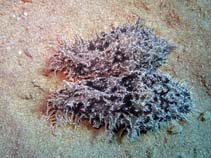Bursatella leachii de Blainville, 1817
Ragged seahare| Native range | All suitable habitat | Point map | Year 2050 |

|
| This map was computer-generated and has not yet been reviewed. |
| Bursatella leachii AquaMaps Data sources: GBIF OBIS |
Classification / Names Common names | Synonyms | CoL | ITIS | WoRMS
Gastropoda | Anaspidea | Notarchidae
Environment: milieu / climate zone / depth range / distribution range Ecology
Benthic; depth range 0 - 30 m (Ref. 7727). Tropical; 15°C - 30°C (Ref. 81113)
Distribution Countries | FAO areas | Ecosystems | Occurrences | Introductions
Circumglobal tropical, temperate seas and the Mediterranean Sea.
Length at first maturity / Size / Weight / Age
Maturity: Lm ? range ? - ? cm Max length : 25.0 cm TL male/unsexed; (Ref. 81112)
Short description Morphology
This is a medium- to large-sized benthic opisthobranch mollusc. The body is variably colored, grayish-green to white-tan with dark brown blotches and spots, compact and rounded, with distinct head and neck regions evident. The body is also covered with numerous long, branching fleshy papillae that give the animal its ragged appearance. The gill is covered by a pair of fleshy parapodia. Two long retractile olfactory tentacles called rhinophores occur on the head, and also two fleshy enrolled oral tentacles occur at each side of the mouth. Adults completely lack a shell.
Assumed maximum length from Ref. 844.
Life cycle and mating behavior Maturity | Reproduction | Spawning | Eggs | Fecundity | Larvae
This is a cross-fertilizing simultaneous hermaphrodite. This is done through internal fertilization wherein one individual transfers its sperm by its eversible penis on the right side of the head to the gonopore of the other individual on the dorsal side. It then lays spaghetti-like benthic egg masses in orange, yellow, green, or brown colors. This is comprised of capsules that contains 1 to 20 eggs. Sexual maturity is attained at the age of 2 to 3 months. Reproductive season is still undefined (Ref. 125338). Come inshore during March and April to lay its eggs. Copulation goes from several hours to several days. Once the eggs are laid, the adults return to shallow waters to die (Ref. 125338).
Main reference
References | Coordinator | Collaborators
Burn, R. 2006. (Ref. 7727)
IUCN Red List Status (Ref. 130435: Version 2024-1)
CITES status (Ref. 108899)
Not Evaluated
CMS (Ref. 116361)
Not Evaluated
Threat to humans
Human uses
| FishSource |
Tools
More information
Trophic Ecology
Ecology
Population dynamics
Life cycle
Human Related
Aquaculture profile
Stamps, Coins Misc.
Stamps, Coins Misc.
Outreach
References
Internet sources
BHL | BOLD Systems | CISTI | DiscoverLife | FAO(Publication : search) | Fishipedia | GenBank (genome, nucleotide) | GloBI | Gomexsi | Google Books | Google Scholar | Google | PubMed | Tree of Life | Wikipedia (Go, Search) | Zoological Record
Estimates based on models
Preferred temperature
(Ref. 115969): 14 - 29.1, mean 27.3 (based on 4479 cells).
Price category
(Ref. 80766):
Unknown.



